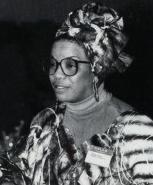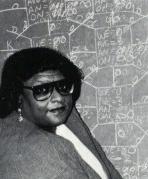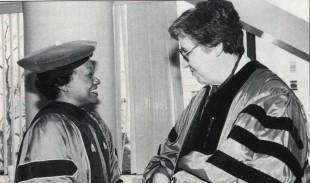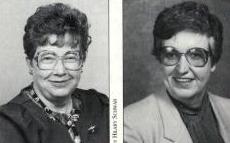|
C.J. Houtchens, American University Magazine, Pages 15-19, Winter 1994 | |

| 
|
| Elaine Smith points the way in a classroom at the District of Columbia's Wilson High School, where she teaches and also directs a new after-school tutoring project, the Math Center. Smith, who taught at the college level for many years, decided that she could steer more kids into math by reaching them in high school, before they begin to opt out of hard courses. "Our kids are slipping through the cracks," she says. "We have to meet them where we find them and move them from here." | Joan Sterling Langdon takes a rare pause at her desk at Bowie State University, Maryland, where she is an associate professor of computer science. For the past four years, Langdon has also served as director of an undergraduate and graduate student training program at NASA's Goddard Space Flight Center, co-sponsored by the center and Bowie State. "The 'Dr.' in front of your name really makes a difference to NASA," she says. |

| 
|
| Martha Brown demonstrates her teacher training workshops leadership style. Brown, supervisor of Mathematics for Prince George's County, Maryland, schools, oversees curriculum and staff development for the county's 175 kindergarten through twelfth-grade schools, a job that keeps her on the road in Prince George's and at conferences around the country. Nevertheless, she is working part-time on another degree...in divinity, at Wesley Seminary. | Linda Hayden '89 works out at the blackboard at Elizabeth City State University, North Carolina, where she is a professor in the department of mathematics and computer science. Hayden recalls graphing functions at home for hours as a high school student "because they were beautiful to me." Today, in addition to regular teaching duties, she pursues grants to provide math conference trips and special project experience for a select group of undergraduate math majors she calls "Hayden's Scholars." |

| 
|
| Ann Taylor, vice president of academic affairs and dean of the faculty of Bethune-Cookman College, left, savors a sweet moment with her former Ph.D. advisor and mentor, AU professor of mathematics and statistics Mary Gray, following the April 1992 ceremony in which Taylor received one of the university's first Lodestar awards, recognizing her achievements. |
|
| The women in this story are in a minority group so small
that in some years when national statistics are gathered, there is no
one in the category at all. These women have paid a high price to be counted
among their small number and have beaten the long odds place against them
simply because of their gender and race. Martha Brown '89, Linda Hayden '89, Joan Sterling Langdon '89, and Elaine Smith '88 hold Ph.D.s in mathematics from American University. Their colleage Ann Taylor '88 earned her AU doctorate in education administration with an emphasis on teaching college level mathematics. Their achievement defies the notion that females should abandon math in junior high school and leave the difficult calculations to men. It rejects the idea that an advanced degree is not an attainable goal for African-Americans, who historically have not funneled into the graduate school system at a rate anywhere near comparable to that of white American's. In the seven years 1985 through 1991, according to a National Research Council survey contained in the June 1992 Commision on Persons in Science and Technology report Professional Women and Minorities, 1997 white men, 470 white women, 27 African-American men and a mere 12 African-American women in the entire United States reported having earned a doctorate in mathematics. It doesn't take more than a knowledge of simple arithemtic to figure out that AU's four female African-American math PhD.s represent a full one-third of a very elite club. And with four more African-American women currently working on math doctorates at AU, it's clear the success of those seven years wasn't just a fluke. We must be doing something right. If you ask Nina Roscher, chair of AU's chemistry department and a faculty member since 1974, what is it that makes the difference, her cheeks pinken and she says quietly, Dr. Mary Gray and I work hard for women. Gray, a former chair of AU's mathematics and statistics department and a professor there since 1968, is the person most often credited with focusing AU's commitment to women and minorities in math. Roscher has had similar success bosting AU's stats for women and minorities with Ph.D.s in her own field. I was one of 9 women out of 450 chemistry graduate students working toward a 1964 Ph.D. at Purdue University, Roscher recalls, with a slight tightening of her lips. Very unpleasant...It certainly has a lot to do with why I am committed. Gray claims to have had an easier time in grad school at the University of Kansas. Except, she says, I had a jerk for my first class, who said, what are you doing here? Why don't you stay home and take care of kids? But that just made me work harder. Gray has long been committed to civil, women's and human rights, and was elected chair of Amnesty International USA last fall. Both Gray and Roscher have been in the trenches, and neither is the type to pull punches. Graduate school in math is an arduous and at least three year long haul in a woman's prime child bearing time...with no guarantees of good jobs, promotions, or tenure at the other end, says Gray. There is just point blank prejudice on the part of people in the mathematical community that women can't do math...When I started out thirty years ago they would say it. Now they don't say it, but it still affects their hiring decisions, their promotion and tenure decisions, Gray says. Adds Roscher, And we can't appreciate fully the problems that black women face. But being realistic about all those problems is the first thing AU does right. For starters, through networking with professional associations, other academic institutions, and alumni of the mathematics Ph.D. program, the university makes a conscious effort to attract women to the program who may have been out of school for a while. Candidates for the mathematics education doctorate must have already earned a master's degree in either math or education. Both Gray and Roscher say that older students tend to be more committed to completing the Ph.D. but they also often have more demands to juggle - like spouses and children - and are likely to be giving up fairly comfortable earnings in order to take on the life of a student again. Linda Hayden had earned a masters of teaching in mathematics from the University of Cincinnati in 1972 and was teaching math and computer science at ECSU, North Carolina, when she decided that she really needed a Ph.D. She tried a computer science program at another university first but encountered a lot of frustration, she says. The program was brand new...Courses weren't in place and teachers couldn't give you a curriculum and say, Choose from these courses. When you do this amount of work then you will take your comprehensive examinations and so on...It was all men, and there was just no understanding at all, no role models there...I said, this is just not do-able at this time at this institution. Hayden settled for a master's degree in computer science instead, as did her graduate school colleage, Joan Sterling Langdon. But Langdon kept looking. When she heard about the AU program she says, I called Linda up in the morning, somewhere like 6 o'clock...She listened. She said, Ok. Then she hung up the telephone. I rolled over and went back to sleep, laughs Hayden. She called me back about an hour later, and she said, Joan, I really wish you hadn't called me, Langdon jokes. Then, of course, everything started developing. Joan and I were both very motivated...and were looking for a place where earning the Ph.D. was do-able within a finite amout of time, Hayden explains. We got the impression that if we were dedicated and worked hard, we would get it. We didn't mind that...Like I tell my students, Put your butt in the chair and your head in the book...But sometimes you can get into situations where there are a lot of politics involved. Also, being black women, in places where there is a lot of racism, there are a lot of other undercurrents that sort of deter you from your goal. We didn't feel that when we visited AU. You don't want to go to a school where you don't think you are going to get out of there, says Ann Taylor. At Bethune-Cookman College in Daytona Beach Florida, where she has taught since 1968 and is now vice president of academic affairs and dean of the faculty, Taylor knows two faculty members who had gotten doctorates from AU. American had a track record, as far as I was concerned, with African-Americans being able to complete their work. Thats the kind of track record that historically black schools, colleges, and universities - like Bethune-Cookman - have enjoyed for many years. For one thing, they offer strong role models. For another, says Elaine Smith, they have the repuations of being far more nurturing and supportive of their students. Both are factors AU College of Arts and Sciences dean Betty Bennett points to in assessing AU's success. The College of Arts and Sciences has always had a large number of women faculty members, she says. Out of twenty-five women on the math and stat faculty, six, or 24 percent, are women - a high percentage considering that nationally women constitute only 5 percent of math faculties at Ph.D. granting institutions. Two of AU's female math faculty are tenured full professors. One of those, Nancy Flourney, is the current department chair. These women, who have accomplished so much themselves, have served as role models to the students, Bennett says. And the commitment of the faculty to increasing the numbers of women and minorites has they realize that they are coming to a supportive environment. But supportive, as Joan Langdon points out, doesn't necessarily mean coddling. Langdon grew up in South Carolina during the days of segregation and attended an all black high school. The teachers were not just peachy keen and everything that you did was wonderful. They let you know when you were messing up and they let you know when you were doing the right thing, she says. That is the way it is with Mary Gray...Primarily, she made sure that we stayed on track and did our work and got out of the American University. Langdon remembers a time when she was working on her dissertation and was really busy but wanted to go home a Christmas to see her dad. Dr. Gray said to me, go...when you finish your degree. Langdon says her father laughed and agreed, well, you know you really should work before you play. Mary has been a wonderful friend, says Ann Taylor. I am not going to say that I was happy with Mary all the way through, because sometimes she gave me a fit. But it was all worth it. She was that way because she wanted me to do well and she wanted me to do my best. Elaine Smith and Mary Gray both acknowledge that they butted heads through most of the ten years that Smith was working on her degree while also teaching as an adjunct faculty member. There were a lot of things I admire about Mary and still do...but we are both very strong women, very strong women...You know she didn't take much. I didn't take much. I have a mouth. She has a mouth. You get the picture, Smith Says. For Smith, support also came in the form of classmates - a network Gray explicity encourages. I would never have made it without them, Smith says. Never. I bugged people to death. Child, there were spouses who stopped talking to me because I was calling up their husbands so much at night looking for help with complicated concepts. I didn't even care because I had to get it, and they were willing to help me get it. That is how I survived. Says Martha Brown, The big thing for me was, would AU permit part time participation in the program? I had a job. I needed a job. And if I was going to get a Ph.D. I had to do it on a part time basis. That was not a problem with AU. But the other women were taking time out of their already established careers and looked to the university for solid financial help. That's were part time teaching positions and Nia Roscer came in. Roscher has spent more than half her career in university adminstration, particularly in graduate and academic affairs, and since 1986, has also held a part time position as program director of science education in the National Science Foundation. She knows the world of grants cold and since 1981 has used that expertise to bring hundreds of thousands of dollars to AU for more than thirty women and minority students in math, chemistry, and law, through the federal government's Patricia Roberts Harris Fellowship Program. Names for the first African-American woman to attain a cabinet position (secretary of housing and urban development and of health education and welfare under Pres. Jimmy Carter) and to head a U.S. law school (at Howard University) the program provides selected gradaute schools with stipends for students whose race or gender or both have been, in federal jargon, underrepresented in certain fields. For mid-career students like Hayden, whose husband and nine year old son packed up and moved to Washington with her, and Langdon, who when she came to AU was a single mother with six year old twin girls and a thirteen year old daugther, the stipends made all the difference. Make no mistake, for every one of these women, getting a Ph.D. was a sacrifice. But they have more than gender and race in common. These women also possess incredible energy - just try pinning one of them down on the telephone after six o'clock in the morning or before ten o'clock at night and another quality, one that perhaps can best be called tenacity. Says Elaine Smith, It was a struggle, honey. It was a long and hard struggle from beginning to end...I am fond to this day of telling my students that I got my Ph.D. in Perseverence. At some point I just refused to walk away not having that piece of paper to show for all the time and energy that I know I had already put into it. It was tough for me, says Ann Taylor, who burned up I-95 and the airlines between Washington, where she lived while working on her degree and Daytona Beach, where her husband is on the faculty at Bethune-Cookman. I shed a lot of tears. I can remember many an evening leaving the campus and crying all the way through Rock Creek Park as I drove home. But I don't know anybody who gets through a doctorate without sheding a tear. And was it worth it? I can honestly say yes. We were up a lot of hours, we were poor, we went through a lot of changes...but it was all worth it. It was a good move, Langdon says. Yes, says Smith. To see the looks on my students faces as I tell them the stories of how I went after that degree and to hear them ask me why it is that they call me Doctor, giving them opportunity to share some of these things, that alone has been worth it. What with the promotions and the job offers, the conferences and the grants, and the recognition that all of these women have received since earning that degree, it would be easy to say that Smith is just mouthing platitutes. But that's clearly not her style. What she is talking about is indeed the real payoff of AU's success...because the women in this story belive that every African-American woman who achieves that Ph.D. is a new role model for an elementary school child, or a high school student, or a college student who could be in graduate school someday and on the way to making sure that this small group gets bigger faster. Says Linda Hayden, who has returned to teaching at historically black Elizabeth City State University, where this past year 60 percent of the seniors from a group she mentored decided to go on to graduate school, That's what gets me up in the morning. | |
|
| |